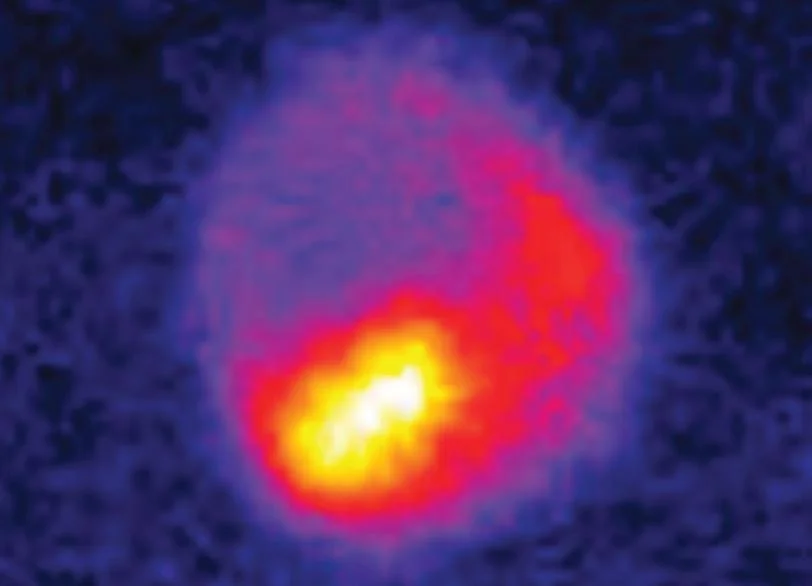Researchers at the Department of Energy's SLAC National Accelerator Laboratory have found new behavior in an ultrathin material that offers a promising method for manipulating light. This method will be useful for devices that detect, control, or emit light and for studying how light is polarized within a material. This research was published in the journal Nano Letters.
 Snapshot taken by SLAC’s high-speed electron camera, an instrument for ultrafast electron diffraction (MeV-UED), showing evidence of circular polarization of terahertz light by an ultrathin sample of tungsten ditelluride. Image Credit: Sie et al., Nano Letters
Snapshot taken by SLAC’s high-speed electron camera, an instrument for ultrafast electron diffraction (MeV-UED), showing evidence of circular polarization of terahertz light by an ultrathin sample of tungsten ditelluride. Image Credit: Sie et al., Nano Letters
The researchers made these discoveries while taking pictures with the high-speed “electron camera.” Numerous everyday technologies, such as medical imaging, optical cables, and light-emitting diodes (LEDs), depend on optoelectronic devices.
The team, led by SLAC and Stanford Professor Aaron Lindenberg, discovered that an ultrathin film of tungsten ditelluride, which has desirable properties for polarizing light used in optical devices, will polarize incoming light in a circular pattern when oriented in a particular direction and exposed to linear terahertz radiation.
Terahertz radiation falls between the microwave and infrared regions in the electromagnetic spectrum. It offers new possibilities for material property management and characterization. Scientists would like to figure out how to harness light to create optoelectronic devices.
The MeV-UED, the world-leading instrument for ultrafast electron diffraction at the Linac Coherent Radiation Source (LCLS) at SLAC, can capture interactions at ultrafast speeds, which is precisely what is needed to capture a material's activity under terahertz radiation.
This new work used the femtosecond electron pulses to visualize the electric and magnetic fields of the incoming terahertz pulses, which caused the electrons to wiggle back and forth. Normally, the MeV-UED is used to visualize the motion of atoms by measuring how they scatter electrons after hitting a sample with an electron beam.
Images of the electrons in the investigation that displayed a circular pattern rather than a straight line indicated circular polarization.
The substance was so thin, just 50 nm thick.
This is 1,000 to 10,000 times thinner than what we typically need to induce this type of response.
Aaron Lindenberg, Professor, Stanford Institute for Materials and Energy Sciences
Scientists are eager to use these incredibly thin materials, sometimes referred to as two-dimensional (2D) materials, to reduce the size and increase the functionality of optoelectronic devices. According to Lindenberg, they see themselves building devices out of layers of 2D structures, much like Legos.
A distinct material would make up each 2D structure, which would be perfectly aligned to provide a particular kind of optical response. These many shapes and functionalities can be combined to create small devices with potential uses, such as optoelectronic devices or medical imaging.
This work represents another element in our toolbox for manipulating terahertz light fields, which in turn could allow for new ways to control materials and devices in interesting ways.
Aaron Lindenberg, Professor, Stanford Institute for Materials and Energy Sciences
This research was funded by the DOE Office of Science and used the resources of the National Energy Research Scientific Computing Center (NERSC). LCLS and NERSC are DOE Office of Science user facilities.
Journal Reference:
Sie, E. J., et al. (2024) Giant Terahertz Birefringence in an Ultrathin Anisotropic Semimetal. Nano Letters. doi.org/10.1021/acs.nanolett.4c00758.